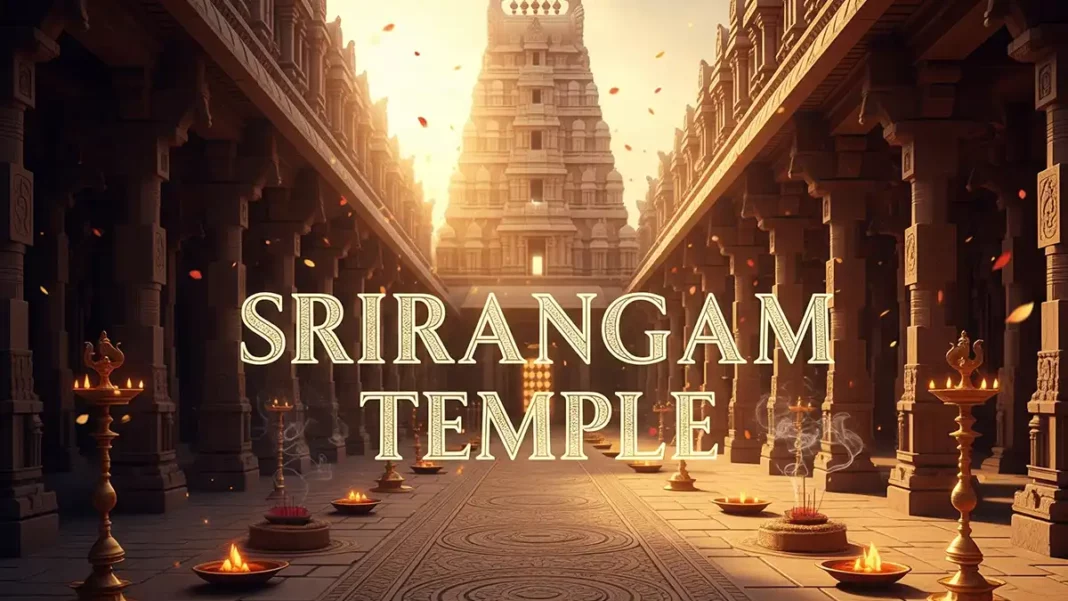The quite well-known Srirangam Temple, which is also called the Ranganathaswamy Temple Srirangam, is nothing but a magnificent representation of South Indian culture, devotion, and architectural mastery. Situated somewhere close to Trichy in the very bustling town of Srirangam, this temple complex is mostly well known for its immense size, spiritual significance and rich history. Every visitor, whether they are a pilgrim, history buff, or architectural enthusiast, is pretty sure to be deeply impacted by this Temple, which is one of the biggest operational Hindu temples in the world.
A Brief Introduction to Srirangam Temple
The reclining form of Lord Vishnu, known as Lord Ranganatha, and his consort, known as Ranganayaki, are worshipped in Srirangam Temple. The location of this temple is somewhat special and spiritually charged because it sits on an island that has been created by the rivers Kaveri and Kollidam. Mount Ranganathaswamy, in addition to being the most important of the 108 Divya Desams (holy Vishnu temples), is also a living example of the development of religion and culture over many centuries.
Srirangam Temple Timings
For those considering a visit, the Srirangam temple timings today are quite essential. The temple usually opens early in the morning and stays open until late in the evening, meeting the demands of thousands of devotees every day. Here is an overview of the daily schedule:
| Section/Sannathi | Opening Time | Closing Time | Notes |
| Main Sanctum (Ranganathar) | 6:00 AM | 9:00 PM | Seva and pooja timings vary |
| Ranganachiar Sannathi | 6:30 AM | 9:00 PM | Alternating paid and free seva periods |
| Afternoon Break | 12:00 PM | 1:15 PM | Sanctum closed for rituals |
| Evening Worship | 6:45 PM | 9:00 PM | Special poojas and Aarti |
Special rituals and poojas take place at various intervals and times that vary throughout festival days.
History and Significance of Srirangam Temple
The temple has a thousand-year history, dating back to the Chola dynasty and then expanded by the Pandya, Hoysala and Vijayanagara empires. The temple has long been a center of Vaishnavite worship and study, and the Alvars (Tamil poet-saints) have exalted it in their cherished songs. The Trichy Srirangam Temple is quite commonly referred to as “Bhooloka Vaikuntam”, which refers to Lord Vishnu’s earthly dwelling.
The temple complex comprises somewhere over 156 acres, making it one of the world’s largest religious complexes. The seven concentric prakaras (enclosures) that this place consists of represent the path from the physical world to spiritual enlightenment, while its 21 gopurams (towers) are beautiful specimens of Dravidian architecture.
Architectural Marvels of Srirangam Temple
Visitors to this Temple are no doubt sure to be quite impressed by its architectural splendor. Some of the most prominent features include:
- Seven Prakaras: The entire temple is surrounded by seven huge walls, each of which has its very own significance and history.
- Rajagopuram: At around 72 meters (236 feet), this is surely Asia’s highest temple tower and a distinguishing feature of the Srirangam skyline.
- Thousand-Pillar Hall: An artistically carved mandapam (hall) that demonstrates the craftsmanship of old artists is one of the best features of this temple complex.
- Shrines and Mandapams: The entire temple complex has around 50 shrines and 39 pavilions, each with its own deity and narrative.
- Sacred Water Tanks: The temple contains nine sacred water pools that are used for the tasks of ceremonial cleaning and religious festivities.
Spiritual Experience at Srirangam Temple
A trip to the this Temple can surely be incredibly life-changing. Following a ceremonial route via the prakaras, the devotees make their arrival at the sanctum sanctorum for Lord Ranganatha’s darshan. Mostly a place for devotion and mental serenity, the temple is known for its colorful festivals, everyday rituals and spiritual atmosphere.
Major Festivals
- Vaikunta Ekadasi: The most major event, held in December-January, draws more than a million devotees.
- Rathothsavam (Chariot Festival): The processional deity is led around the temple in a huge chariot, accompanied by music and dance.
- Adhyayanotsavam: A month-long event in the Tamil month of Margazhi that includes the reading of religious hymns and cultural performances.
Srirangam: The Temple Town
The town of Srirangam is quite largely associated with the temple itself. The temple complex is surrounded by an extremely thriving community, complete with dwellings, stores and markets enclosed within its outer walls. This distinct “temple-town” typology is quite uncommon and contributes to the immersion experience of visiting the Trichy Srirangam Temple.
Ranganathaswamy Temple Srirangam: Legends and Lore
The Ranganathaswamy Temple in Srirangam is steeped in tradition. It is considered the first and greatest of Lord Vishnu’s eight self-manifested shrines (Swayam Vyakata Kshetras). According to legend, Lord Brahma worshipped the idol of Lord Ranganatha before giving it to King Ikshvaku. The temple’s corridors and walls are pretty much covered with inscriptions and murals that wonderfully tell these old stories.
Shrines and Deities in Srirangam Temple
The Srirangam Temple contains multiple shrines dedicated to various manifestations of Vishnu and his consort Lakshmi, as well as saints and legendary personalities. Some of the prominent shrines are:
- Arulmigu Kambathadi Hanumar
- Arulmigu Annamoorthi Sannathi
- Arulmigu Chakarathalwar Sannathi
- Arulmigu Krishnar Sannathi
- Arulmigu Srinivasa Perumal (Manalveli)
- Arulmigu Thirukkachi Nambikal
- Arulmigu Emperumanar (Ramanuja) Sannathi
Each shrine is special, having its own ceremonies and festivals held throughout the year.
Srirangam Temple: A Living Heritage
This Temple is way more than just an architectural marvel; it is also a living symbol of religion and tradition. It, till date, continues to attract devotees and tourists from all over the world, serving primarily as a center for spiritual instruction and cultural exchange. The temple’s management ensures that old customs are properly maintained while accommodating the needs of modern guests.
Conclusion
The Srirangam Temple is nothing but a true masterpiece of devotion, architecture and living tradition. Ranganathaswamy Temple Srirangam, with its towering gopurams and sacred rites, as well as its oh so bustling temple town and such rich history, is sure to inspire awe and devotion in every visitor. Whether you are looking for spiritual peace, cultural immersion, or even a view into South India’s rich history, the Temple remains a timeless light, inviting those who seek the holy.
Keeping track of this temple timings today assures a smooth and enjoyable experience. The temple is quite a dynamic center of faith, attracting millions to its sacred halls and creating a legacy that is unrivaled in the world of Hindu temples.
Frequently Asked Questions (FAQs)
Q: What are the Srirangam temple timings today?
A: The Srirangam temple is open from 6:00 a.m. to 9:00 p.m., with specified darshan and pooja times throughout the day. Timings may differ on festival days.
Q: Where is this temple located?
A: The temple is located in the town of Srirangam, near Trichy (Tiruchirapalli), Tamil Nadu, on an island between the Kaveri and Kollidam rivers.
Q: Is photography allowed inside this temple?
A: Photography is often prohibited in the inner sanctum, but permitted in the exterior regions. It is advisable to consult with temple officials.
Also Read:
Brihadeshwara Temple: Great Ancient Indian Architecture
David William comes from an Engineering background, with a specialization in Information Technology. He has a keen interest and expertise in Web Development, Data Analytics, and Research. He trusts in the process of growth through knowledge and hard work.


